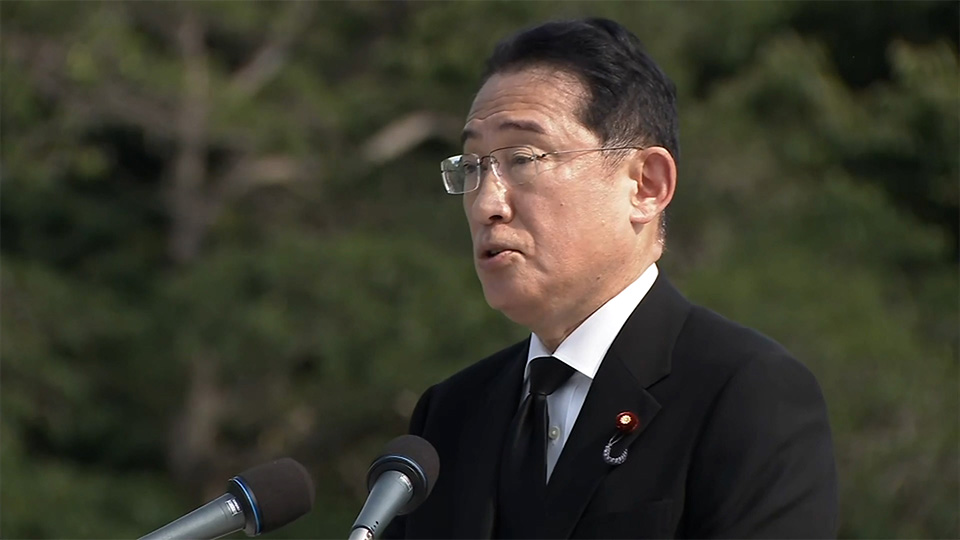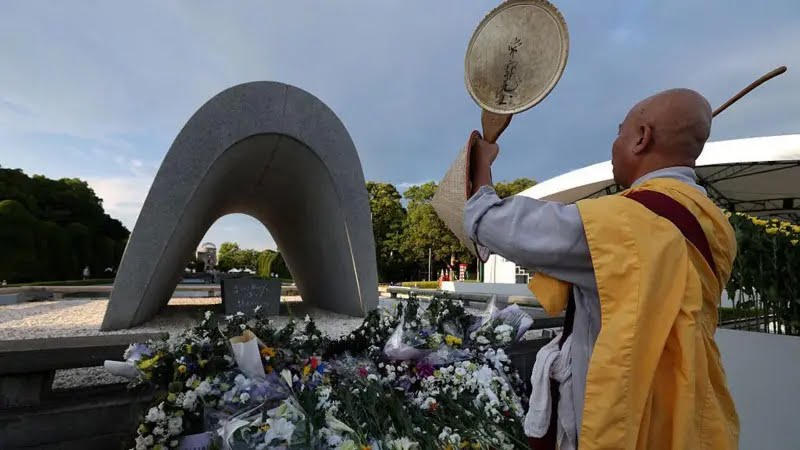
Prime Minister Fumio Kishida of Japan
Hiroshima holds 80th atomic bomb memorial as aging survivors call for nuclear abolition

Tuesday marks 80 years since an atomic bomb dropped by the United States devastated the Japanese city of Hiroshima. Mayor Matsui Kazumi has called on people to press leaders relying on nuclear deterrence to shift their policies.
A ceremony to commemorate the victims was held at the city’s Peace Memorial Park from 8 a.m. About 50,000 people participated, including atomic bomb survivors and bereaved families, Japanese Prime Minister Kishida Fumio and representatives from 109 countries.
During the ceremony, Mayor Matsui said it seems that global crises are reinforcing the public assumption that military force must be relied on to solve international problems — and that we should be rejecting this idea.
“Our unity will move leaders now relying on nuclear deterrence to shift their policies,” Matsui said.
Hiroshima Mayor Matsui Kazumi wants Japan to become a party to the UN nuclear ban treaty.
The mayor requested the Japanese government to participate as an observer in the third meeting of the states parties to a UN treaty banning nuclear arms next March.
He also urged the country to become a party to the treaty as soon as possible.
An updated list of atomic bomb victims was placed inside a cenotaph at the park. It includes the names of those who survived the bombing but died over the past 12 months. The list now has 344,306 names. Then there was a moment of silence at 8:15 a.m., the exact time the bomb was dropped in 1945.
This year’s ceremony comes alongside increased fears that nuclear weapons could be used again. Russia’s invasion of Ukraine has entered its third year with repeated nuclear threats. Israel’s fierce offensive continues in the Gaza Strip.
Kishida stresses resolve to increase momentum for nuclear disarmament
Kishida says Japan will make realistic and practical efforts while leading the international community to increase momentum for nuclear disarmament.
“The calamities that struck Hiroshima and Nagasaki 79 years ago and the suffering endured by the people must not repeated,” Kishida said.
He said that conveying the realities of the atomic bombings, firmly maintaining the country’s Three Non-Nuclear Principles and making consistent efforts to pursue a world free of nuclear weapons are the missions of Japan — the only nation to have suffered atomic bombings.
“The deepening divide in the global community over nuclear arms reduction as well as nuclear threats made by Russia are turning the environment surrounding nuclear disarmament even bleaker,” Kishida said. “But no matter how rocky the path toward a world without nuclear arms may be, we simply cannot stop our progress.”
The prime minister also pointed out the significance of the proposed Fissile Material Cut-off Treaty, which would ban the production of components of nuclear weapons. He suggested he will aim for the start of international negotiations on the treaty.
Survivor passes down his experience
Atomic bomb survivor Hironaka Masaki, 84, laid flowers at the cenotaph during the ceremony as a representative of fellow survivors.
Hironaka was 5 years old when he lost his father to the bombing. His father came home with a lot of glass stuck in his back and was exposed to radiation while on a train going to work. He died the following day.
“Standing in this place reminds me of what happened in Hiroshima 79 years ago and my father’s tragedy,” Hironaka told reporters.
As Hironaka grew elderly it became difficult for him to actively speak about his experience. Now he is sharing it with more than 10 people in the hope they will pass his memories on to future generations.
“I am too old to actively share my story so I feel a little relieved to be able to pass it down to others. I hope many people will visit Hiroshima and Nagasaki and send out messages, including mine, to create a peaceful society,” Hironaka said.
A moment of silence in Hiroshima
When the bomb exploded above Hiroshima at 8:15 a.m., the heat and radiation from the blast devastated the city, killing about 140,000 people by the end of the year. Many survivors went on to suffer from cancer and other diseases related to radiation exposure.
A woman in Hiroshima City quietly prays together with her mother and two children while facing the Atomic Bomb Dome.
The woman said her grandparents were exposed to the bombing. “I put my hands together in prayer, hoping that war will never happen again. I hope today is an opportunity for children to think about world peace.”
A female high school student from Hiroshima City, who observed the moment of silence in the memorial park, said, “Some families around the world cannot live together due to war. I want the world to be peaceful by conveying the sadness of war from Hiroshima.”
At a care home for atomic bomb survivors in the city, about 20 people gathered to watch a live broadcast of the ceremony. At 8:15 a.m., they placed their hands together in silence.
Kawasaki Satoko was 14 when the bomb was dropped. Now 93, she said she lost many of her school friends because of it. “I offered prayers while remembering those people. Many years have passed, but I feel that the day when the bomb was dropped is like yesterday. I strongly hope that nuclear weapons will be abolished.”
Uwamura Kimie was also 14 when the bomb was dropped. She remembers her brother losing his eyesight. “I don’t want to talk about the war anymore. I just hope for a peaceful society,” she said.
Children learn the importance of peace
Elementary schools in various parts of Hiroshima City held special classes to think about peace.
At Hiroshima University Elementary School, children gathered at the gymnasium for a peace class. Six sixth graders gave a presentation about their visit to the Hiroshima Peace Memorial Museum.
They said they learned not only that many lives were lost in the bombing but also that survivors suffered from burns and aftereffects caused by radiation.
The six students said it is necessary to understand the importance of peace and take action to prevent war.
Survivors call for abolishment of nuclear arms
Atomic bomb survivor Abe Shizuko, 97, gave a speech in the city about her A-bomb experience and stressed the inhumane nature of nuclear weapons.
Abe was exposed to radiation about 1.5 kilometers from the epicenter while working as a volunteer at the age of 18. Her right hand became disabled and her face and other parts of her body were marred by keloids.
“I had surgery 18 times, but those areas didn’t return to normal,” Abe said. “I want people to think about nuclear weapons on a personal level. This is the wish of an atomic bomb survivor who has lived tearfully while suffering.”
Around 70 people listened to Abe’s speech including Matsuda Jin, her 10-year-old great-grandson.
“I felt sorry and scared to hear the experience of my great grandmother. I want to act to help abolish nuclear weapons,” he said.
“We must never use nuclear weapons that create atomic bomb survivors like me,” Abe said. “I hope Japan, as a country that suffered atomic bombings, will send out the message more strongly.”
Atomic bomb survivor Suemasa Sadako, 90, also shared her experience with junior high and high school students who are visiting Hiroshima from the northern prefecture of Hokkaido.
Suemasa was exposed to radiation about two kilometers from the epicenter and her leg was smashed by flying glass.
Her mother suffered severe burns. At the time there was a widespread rumor that ground-up bones could heal such wounds so Suemasa dug up remains buried in the schoolyard to save her mother.
“I still shed tears when thinking of what happened but I want to keep talking about my experience. We shouldn’t make nuclear weapons. We have to maintain peace,” Suemasa said. “Nuclear weapons and humans can’t coexist. Atomic bombs will lead to the destruction of mankind.”
Paper cranes: A symbol of peace:
NHK World’s Yoshikawa Ryuichi reports from Hiroshima City.
I am at the Children’s Peace Monument, which features a statue of a girl holding a paper crane. It was built to commemorate Sasaki Sadako and is dedicated to all the children who died in the bombing.
Sadako died of leukemia at the age of 12 after being exposed to radiation from the blast when she was two.
She folded thousands of paper cranes while hospitalized to pray for recovery.
The paper crane has become a symbol of peace not only in Japan but around the world. Thousands are brought here from all over the country.
People have been hanging their cranes here at the monument, which tells us Sadako’s legacy is very much alive.
At the same time, today is a stark reminder of the atrocities of war. This anniversary comes amid the conflicts in Ukraine and Gaza, where many of the casualties have been children.
This year there was a gathering protesting Israel being invited to the ceremony due to its ongoing offensive in Gaza.
Sadako’s brother, Masahiro, says he hopes these paper cranes will remind people of the impact of war on innocent children and his sister’s story keeps being told.
